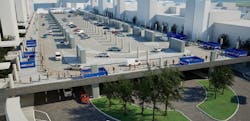How Construction Innovation Is Transforming Passenger Flow and Safety in New England Airports
Five Things You’ll Learn from This Article
-
How phased construction and modular techniques keep terminals, garages, and checkpoints operational during major upgrades.
-
The unique challenges of building at Boston Logan International Airport, one of the nation’s busiest hubs, while balancing safety, security, and passenger flow.
-
The role of digital tools like BIM and AI in improving efficiency, reducing delays, and forecasting potential conflicts during construction.
-
Why sustainability has become a core requirement in airport modernization projects, from LEED®-certified terminals to solar-integrated parking structures.
-
What New England’s next wave of aviation projects will prioritize, including technology-enabled construction, resilience, and progressive delivery models.

Few environments pose as many challenges for builders as airports. Unlike other large-scale facilities, airports must remain operational 24/7 while simultaneously undergoing upgrades to meet the demands of rising passenger traffic, evolving security requirements, and sustainability targets. In New England, one of the nation’s busiest aviation hubs—Boston Logan International Airport—sits at the heart of a regional system that also includes critical mid-sized airports like Rhode Island T.F. Green International Airport and Nantucket Memorial Airport.
Construction companies such as Skanska, with decades of experience delivering complex aviation projects, are reshaping how airport infrastructure is built. Their work highlights the role of innovation in improving passenger flow and safety, while also underscoring the unique challenges of building within dense urban environments and operational hubs. For airport executives and consultants, the lessons learned in New England provide a roadmap for the next wave of modernization across the U.S. aviation sector.
Innovation in Construction: Keeping Passengers Moving Safely
At the core of construction innovation in aviation is the imperative to protect the passenger experience while work is underway. Delays, congestion, or compromised safety are unacceptable in facilities that process tens of millions of travelers annually. According to Bryan Northrop, Executive Vice President and General Manager at Skanska USA Building, New England, innovations in phased construction, modular design, and digital modeling are helping builders minimize disruption.
At Boston Logan’s Terminal C, for example, Skanska consolidated security checkpoints and upgraded HVAC systems in a high-traffic area—all while keeping passengers moving. Careful sequencing allowed ceiling replacements and system upgrades to proceed without shutting down key access points. Similarly, the ongoing Terminal E modernization—a $700M-plus program including new parking and international processing improvements—relies on phased approaches that balance construction schedules with the constant churn of international travel.
Smaller airports provide lessons in scale and adaptability. At T.F. Green Airport in Providence, the expansion of baggage screening and security facilities was completed in an active terminal by sequencing work around operational needs. At Nantucket Memorial Airport, where space constraints are even tighter, new passenger screening and hold room facilities were built while existing operations remained fully functional. In both cases, modular and prefabricated elements accelerated timelines and reduced disruption.
Digital tools also play a key role. Building Information Modeling (BIM) allows teams to anticipate conflicts and optimize logistics before crews set foot on-site. Advanced planning ensures smoother passenger flows, while robotics and AI are increasingly being tested for productivity tracking, quality assurance, and safety monitoring.
Building at One of the Nation’s Busiest Hubs: Logan’s Unique Challenges
Constructing within a busy international hub presents a different magnitude of challenge. Logan Airport, where Skanska has worked with Massport for more than 20 years, exemplifies the need for precision and coordination.
Unlike other facilities, airports require builders to account for both pedestrian and aircraft traffic. “Doing heavy construction work on an active facility such as an airport requires us to consider not just passenger flow but also airside operations and rigorous security measures,” Northrop explained. Each project must integrate with the complex choreography of flight schedules, security standards, and tenant needs.
The Terminal B garage renovation illustrates this balancing act. The $40M project involves repairing drainage, upgrading lighting, and improving traffic circulation while keeping parking operational for thousands of daily commuters. In Terminal E, contractors must coordinate not only with Massport, but also with multiple airlines and the TSA to ensure construction activity aligns with fluctuating international travel demands.
Safety remains the non-negotiable pillar. From ensuring clear evacuation routes during construction to protecting critical systems from disruption, contractors must embed safety protocols into every phase. For consultants and airport executives, this underscores the importance of early contractor involvement and close alignment with operational leaders.
Another layer of challenge is sustainability. Logan’s Terminal A redevelopment set a precedent as the first airport terminal in the world to achieve LEED® certification. Since then, sustainability has become a defining component of Skanska’s projects. The Terminal E expansion includes rooftop and façade solar panels, while Terminal C’s canopy integrates ETFE and solar materials to create a lightweight, energy-efficient roof. For airports, weaving sustainability into the modernization process is no longer optional—it is essential for long-term resilience and regulatory compliance.
What’s Ahead for New England Aviation
The next decade of modernization in New England’s aviation sector will expand beyond traditional capacity projects. Instead, airports are adopting a holistic approach focused on efficiency, passenger experience, and environmental stewardship.
Northrop points to three priorities that will define future projects:
-
Technology-Enabled Construction – BIM, IoT-enabled systems, and AI-driven project management will increasingly reduce costs and delays. Prefabrication and robotics will accelerate timelines while improving quality and safety.
-
Sustainability and Resilience – From Parksmart-certified parking facilities to renewable energy integration, airports will continue advancing green infrastructure. This trend aligns with the broader industry’s push to decarbonize and prepare for climate-related risks.
-
Progressive Delivery Models – Collaborative contracting approaches that bring airport owners, contractors, and stakeholders together early in the process will become standard. These models enable faster decision-making, clearer accountability, and stronger alignment around passenger-focused outcomes.
For regional airports like T.F. Green and Nantucket, the lessons of phased construction and stakeholder engagement will remain highly relevant. Their success in delivering major upgrades while maintaining safe, operational facilities highlights scalable best practices for larger hubs.
Meanwhile, Logan will continue to serve as a testbed for complex, large-scale modernization. With ongoing projects under Massport’s Terminal E Redevelopment and Consolidation (TERC) program, the airport is positioning itself as a leader in international passenger flow, advanced security integration, and sustainable airport design.
For airport executives and consultants navigating the next wave of modernization, New England’s experience offers valuable lessons. The success of projects at Logan, T.F. Green, and Nantucket demonstrates the importance of balancing three imperatives: innovation, safety, and operational continuity.
Phased construction and modular techniques show how major upgrades can proceed without disrupting passengers. Digital tools like BIM reveal how careful planning can cut costs and delays. And sustainability, once a peripheral consideration, is now central to airport competitiveness and compliance.
The aviation industry’s challenge is not simply to build more capacity but to build smarter—facilities that are resilient, passenger-centric, and environmentally responsible. As modernization accelerates, construction innovation will remain the cornerstone of how airports achieve these goals, ensuring that the next generation of travelers moves through safer, more efficient, and more sustainable terminals.
Five Best Practices for Airport Construction Projects
1. Phase Construction Carefully
Breaking projects into manageable phases allows critical areas like checkpoints, baggage systems, and parking garages to remain open while upgrades are underway. Careful sequencing minimizes traveler disruption.
2. Engage Stakeholders Early
Bringing TSA, airlines, tenants, and airport operators into the planning process from day one ensures schedules, access points, and safety requirements are fully aligned.
3. Leverage Digital Tools
Building Information Modeling (BIM), logistics planning, and AI-driven monitoring reduce delays, improve efficiency, and provide better forecasting for potential conflicts.
4. Prioritize Passenger Flow and Safety
Even during heavy construction, traveler movement must remain seamless. Clear signage, temporary circulation routes, and rigorous safety protocols protect both passengers and staff.
5. Build Sustainability In from the Start
From solar-ready designs to energy-efficient HVAC and materials, integrating green infrastructure from day one positions airports for long-term resilience and compliance with industry climate goals.
About the Author
Joe Petrie
Editor & Chief
Joe Petrie is the Editorial Director for the Endeavor Aviation Group.
Joe has spent the past 20 years writing about the most cutting-edge topics related to transportation and policy in a variety of sectors with an emphasis on transportation issues for the past 15 years.
Contact: Joe Petrie
Editor & Chief | Airport Business
+1-920-568-8399
>> To download the AviationPros media kits, visit: Marketing Resource Center
>>Check out our aviation magazines: Ground Support Worldwide | Airport Business | Aircraft Maintenance Technology
